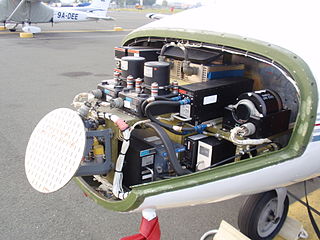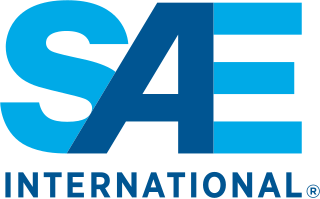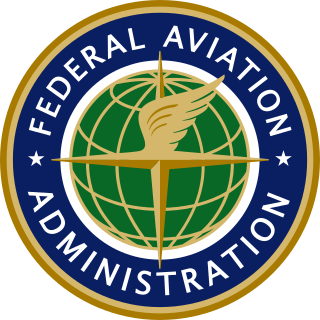
Avionics are the electronic systems used on aircraft. Avionic systems include communications, navigation, the display and management of multiple systems, and the hundreds of systems that are fitted to aircraft to perform individual functions. These can be as simple as a searchlight for a police helicopter or as complicated as the tactical system for an airborne early warning platform.
Avionics software is embedded software with legally mandated safety and reliability concerns used in avionics. The main difference between avionic software and conventional embedded software is that the development process is required by law and is optimized for safety. It is claimed that the process described below is only slightly slower and more costly than the normal ad hoc processes used for commercial software. Since most software fails because of mistakes, eliminating the mistakes at the earliest possible step is also a relatively inexpensive and reliable way to produce software. In some projects however, mistakes in the specifications may not be detected until deployment. At that point, they can be very expensive to fix.

A traffic alert and collision avoidance system (TCAS, pronounced TEE-kas), also known as an Airborne Collision Avoidance System (ACAS), is an aircraft collision avoidance system designed to reduce the incidence of mid-air collision (MAC) between aircraft. It monitors the airspace around an aircraft for other aircraft equipped with a corresponding active transponder, independent of air traffic control, and warns pilots of the presence of other transponder-equipped aircraft which may present a threat of MAC. It is a type of airborne collision avoidance system mandated by the International Civil Aviation Organization to be fitted to all aircraft with a maximum take-off mass (MTOM) of over 5,700 kg (12,600 lb) or authorized to carry more than 19 passengers. CFR 14, Ch I, part 135 requires that TCAS I be installed for aircraft with 10-30 passengers and TCAS II for aircraft with more than 30 passengers. ACAS/TCAS is based on secondary surveillance radar (SSR) transponder signals, but operates independently of ground-based equipment to provide advice to the pilot on potentially conflicting aircraft.
DO-178B, Software Considerations in Airborne Systems and Equipment Certification is a guideline dealing with the safety of safety-critical software used in certain airborne systems. It was jointly developed by the safety-critical working group RTCA SC-167 of the Radio Technical Commission for Aeronautics (RTCA) and WG-12 of the European Organisation for Civil Aviation Equipment (EUROCAE). RTCA published the document as RTCA/DO-178B, while EUROCAE published the document as ED-12B. Although technically a guideline, it was a de facto standard for developing avionics software systems until it was replaced in 2012 by DO-178C.
A hazard analysis is one of many methods that may be used to assess risk. At its core, the process entails describing a system object that intends to conduct some activity. During the performance of that activity, an adverse event may be encountered that could cause or contribute to an occurrence. Finally, that occurrence will result in some outcome that may be measured in terms of the degree of loss or harm. This outcome may be measured on a continuous scale, such as an amount of monetary loss, or the outcomes may be categorized into various levels of severity.

ARP4761, Guidelines for Conducting the Safety Assessment Process on Civil Aircraft, Systems, and Equipment is an Aerospace Recommended Practice from SAE International. In conjunction with ARP4754, ARP4761 is used to demonstrate compliance with 14 CFR 25.1309 in the U.S. Federal Aviation Administration (FAA) airworthiness regulations for transport category aircraft, and also harmonized international airworthiness regulations such as European Aviation Safety Agency (EASA) CS–25.1309.

ARP4754 , Aerospace Recommended Practice (ARP) Guidelines for Development of Civil Aircraft and Systems, is a published standard from SAE International, dealing with the development processes which support certification of Aircraft systems, addressing "the complete aircraft development cycle, from systems requirements through systems verification." Since their joint release in 2002, compliance with the guidelines and methods described within ARP4754 and its companion ARP4761 have become mandatory for effectively all civil aviation world-wide.
RTCA DO-254 / EUROCAE ED-80, Design Assurance Guidance for Airborne Electronic Hardware is a document providing guidance for the development of airborne electronic hardware, published by RTCA, Incorporated and EUROCAE. Initially released in 2000, the DO-254/ED-80 standard was not necessarily considered policy until recognized by the FAA in 2005 through AC 20-152 as a means of compliance for the design assurance of electronic hardware in airborne systems. The guidance in this document is applicable, but not limited, to such electronic hardware items as
DO-242A is an aviation system standard published by RTCA, Incorporated. It contains minimum aviation system performance standards (MASPS) for Automatic Dependent Surveillance-Broadcast (ADS-B). These standards specify operational characteristics that should be useful to designers, manufacturers, installers, service providers and users of an ADS-B system intended for operational use on an international basis. DO-242A provides a view of the system-wide operational use of ADS-B, but does not describe a specific technical implementation or design architecture meeting these operational and technical characteristics.

An electronic flight bag (EFB) is an electronic information management device that helps flight crews perform flight management tasks more easily and efficiently with less paper providing the reference material often found in the pilot's carry-on flight bag, including the flight-crew operating manual, navigational charts, etc. In addition, the EFB can host purpose-built software applications to automate other functions normally conducted by hand, such as take-off performance calculations. The EFB gets its name from the traditional pilot's flight bag, which is typically a heavy documents bag that pilots carry to the cockpit.

MIL-STD-810, U.S. Department of Defense Test Method Standard, Environmental Engineering Considerations and Laboratory Tests, is a United States Military Standard that emphasizes tailoring an equipment's environmental design and test limits to the conditions that it will experience throughout its service life, and establishing chamber test methods that replicate the effects of environments on the equipment rather than imitating the environments themselves. Although prepared specifically for U.S. military applications, the standard is often applied for commercial products as well.
RTCA, Inc. is a United States non-profit organization that develops technical guidance for use by government regulatory authorities and by industry. It was founded in 1935 and was re-incorporated in 1991 as a private not-for-profit corporation. It has over 20 active committees with multiple working groups under each committee and develops industry standards in cooperation with aviation regulators from around the world including the FAA.
Functional safety is the part of the overall safety of a system or piece of equipment that depends on automatic protection operating correctly in response to its inputs or failure in a predictable manner (fail-safe). The automatic protection system should be designed to properly handle likely systematic errors, hardware failures and operational/environmental stress.
DO-178C, Software Considerations in Airborne Systems and Equipment Certification is the primary document by which the certification authorities such as FAA, EASA and Transport Canada approve all commercial software-based aerospace systems. The document is published by RTCA, Incorporated, in a joint effort with EUROC and replaces DO-178B. The new document is called DO-178C/ED-12C and was completed in November 2011 and approved by the RTCA in December 2011. It became available for sale and use in January 2012.
IEC 60068 is an international standard for the environmental testing of electrotechnical products that is published by the International Electrotechnical Commission (IEC).

AC 25.1309–1 is an FAA Advisory Circular (AC) that identifies acceptable means for showing compliance with the airworthiness requirements of § 25.1309 of the Federal Aviation Regulations, which requires that civil aviation equipment, systems, and installations "perform their intended function under foreseeable operating conditions." The present Revision B was released in August 2024. AC 25.1309–1 establishes the principle that the more severe the hazard resulting from a system or equipment failure, the less likely that failure must be. Catastrophic failures must be extremely improbable.

The Advisory Circular AC 20-115( ), Airborne Software Development Assurance Using EUROCAE ED-12( ) and RTCA DO-178( ), recognizes the RTCA published standard DO-178 as defining a suitable means for demonstrating compliance for the use of software within aircraft systems. The present revision D of the circular identifies ED-12/DO-178 Revision C as the active revision of that standard and particularly acknowledges the synchronization of ED-12 and DO-178 at that revision.

FAA Order 8110.105B, Airborne Electronic Hardware Approval Guidelines is an explanation of how Federal Aviation Administration (FAA) personnel can use and apply the publication

The Advisory Circular AC 20-152A, Development Assurance for Airborne Electronic Hardware, identifies the RTCA-published standard DO-254 as defining "an acceptable means, but not the only means" to secure FAA approval of electronic hardware for use within the airspace subject to FAA authority. With the 2022 release of Revision A, this Advisory Circular becomes a very important instrument for completing some guidance of DO-254 and providing applicants with clarifications and additional information on that standard.
The Certification Authorities Software Team (CAST) is an international group of aviation certification and regulatory authority representatives. The organization of has been a means of coordination among representatives from certification authorities in North and South America, Europe, and Asia, in particular, the FAA and EASA. The focus of the organization has been harmonization of Certification Authorities activities in part though clarification and improvement of the guidance provided by DO-178C and DO-254.






